Physical Address
304 North Cardinal St.
Dorchester Center, MA 02124
© 2018 Elsevier Inc. All rights reserved. Please note that the copyright for the original figures submitted by the contributors is owned by Contributors.
After Frazier’s description of bifrontal craniotomy in 1913, Tessier and Derome developed the transbasal approach to the anterior skull base. Numerous modifications of the transbasal approach add varying degrees of bone removal from the supraorbital bar, orbital roof and wall, lateral orbital rims, nasal bones, and paranasal sinuses (frontal, ethmoid, and sphenoid sinuses). Raveh et al. described the subcranial approach in 1988, by including nasal and orbital osteotomies with limited frontal exposure. In 1991, Kawakami et al. employed an extensive transbasal approach that entailed en bloc bilateral orbital roof and frontal sinus osteotomy. A year later, Sekhar et al. described the extended frontal approach which added an orbitofrontal or orbitofrontoethmoidal osteotomy. These modifications of the transbasal approach provide more posterior and inferior exposure of the clivus with less frontal lobe retraction. These midline subfrontal approaches to the anterior skull base and paranasal sinuses remain useful for some spheno-occipital chordomas and chondrosarcomas.
The nomenclature of variations of the midline subfrontal approach ( Fig. 11.1 ) was simplified by Feiz-Erfan et al. into three levels based on the extent of orbitonasal bone removal. The standard transbasal approach is limited to a bifrontal craniotomy without orbital or nasal osteotomy. In the Level 1 transbasal approach, osteotomies of the orbital ridge and nasion (removal of the supraorbital bar) are performed, without disruption of the medial canthal ligaments. This is, in essence, an extended transbasal approach. In the Level 2 transbasal approach, the medial canthal ligaments are detached and a more extensive nasal osteotomy, typically removing the medial orbital wall, the entire orbital rim and nasal bone, is performed. Level 3 transbasal approach adds lateral orbital wall osteotomies that incorporate the inferior orbital fissure. The ability of endoscopic endonasal approaches to complement the standard or Level 1 transbasal approach has reduced the frequency of use of Levels 2 and 3 transbasal modifications. Endonasal approaches (in endoscopic-assisted craniofacial approaches) have supplanted transfacial approaches (in combined craniofacial approaches) as adjuncts to the midline subfrontal approach by providing superior panoramic visualization, better illumination, and avoidance of transfacial skin incisions. In this chapter, we review the standard transbasal approach and its extended modifications. In midline subfrontal approaches, one can access the cribriform plate and perform a total ethmoidectomy, sphenoidotomy, and midline clivectomy down to the craniovertebral junction ( Figs. 11.2 and 11.3 ). The variations of osteotomies and their indications, advantages, and limitations are reviewed below.
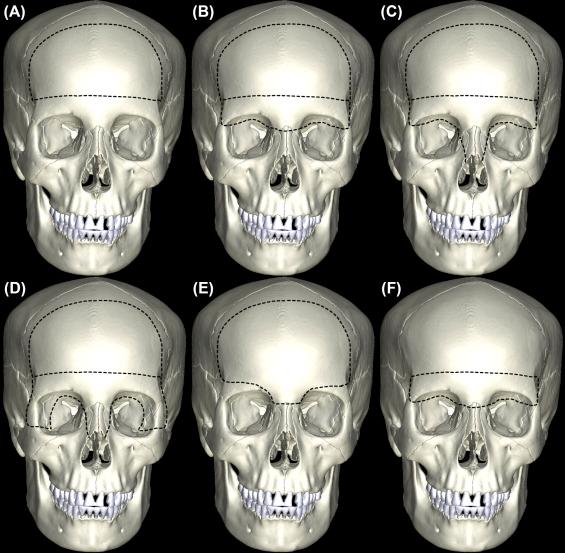
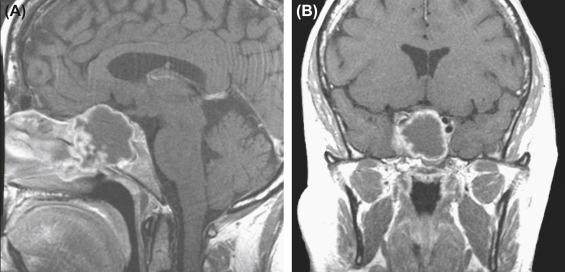
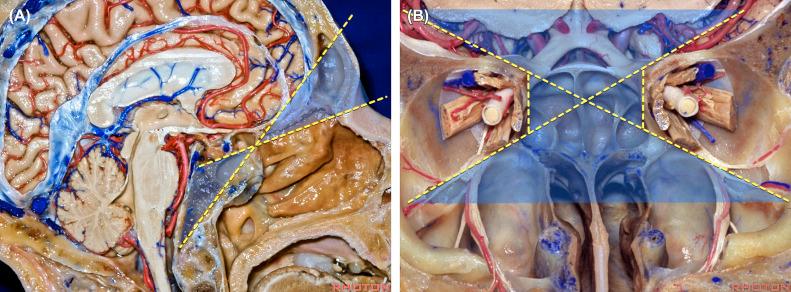
Considerations affecting choice of operative approach to clival lesions include anatomical location, tumor extension in the sagittal and coronal plane, intracranial spread, vascular or cranial nerve encasement, brainstem compression, tumor consistency, prior surgical approach, and surgeon preference. An optimal approach provides both a direct route to the tumor and visualization of the tumor’s interface with critical structures thereby avoiding injury to the optic nerves, carotid arteries, brainstem, and craniovertebral junction. Significant tumor extension into multiple compartments may require a combination of approaches to adequately remove the tumor. Advancements in microsurgical and endoscopic skull base techniques and image guidance have facilitated the surgical management of chordomas and chondrosarcomas.
Preoperative magnetic resonance imaging (MRI) is essential to assess the tumor and any intracranial extension. Computed tomography angiography (CTA) is useful to assess the relationship of the tumor to the patient’s carotid and basilar arterial circulation and the neighboring venous anatomy of the cavernous sinus, petrosal sinuses, and draining veins. CTA is preferred over MRA because of its high resolution of skull base bone anatomy. Digital subtraction angiography (DSA) is reserved for complicated vascular anatomy not adequately assessed in CTA or for balloon test occlusion (BTO) in case of significant arterial encasement. An audiogram is useful for patients with tumor involving the petrous temporal bone or with hearing deficits found in neurologic exam. Swallow evaluation is useful in patients with lower cranial nerve involvement. Preoperative gastrostomy tube placement may be indicated in patients with poor caloric intake. Laryngeal endoscopy can also identify vocal cord paralysis from severe lower cranial nerve dysfunction in which case preoperative tracheostomy may be indicated. Endocrine testing of baseline pituitary function should be performed for patients with sellar and suprasellar involvement.
After induction of general endotracheal anesthesia and establishment of appropriate arterial and venous access, the patient is positioned supine and the head is placed in three-pin fixation ( Fig. 11.4 ). The bed is flexed 10–15 degrees to facilitate venous drainage. The neck is slightly extended to promote frontal lobe relaxation away from the anterior skull base and to reduce the need for brain retraction.
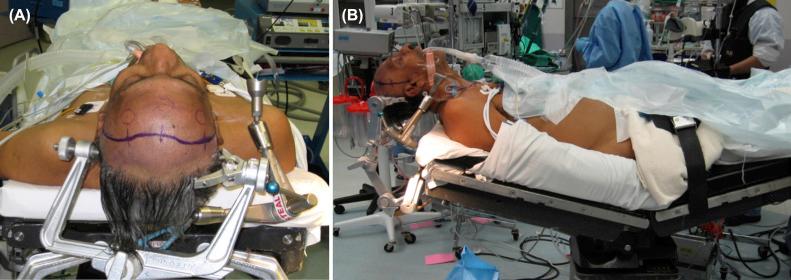
Neuronavigation is utilized to plan the craniotomy and verify anatomic landmarks. Somatosensory, motor, and brainstem auditory evoked potentials and the EMG activity of cranial nerves at risk (e.g., the abducens nerve) are monitored. Antibiotics, mannitol, dexamethasone, and antiepileptics are administered prior to skin incision.
A preauricular bicoronal skin incision behind the patient’s hairline is extended from one zygoma to the other, no more than 1 cm anterior to the tragus ( Fig. 11.4 ). The nose and nares are also prepped in case endoscopic endonasal exploration is required to remove additional tumor from the sinuses or to harvest a pedicled nasoseptal flap to aid in anterior skull base reconstruction. The face can be prepped in case an open transfacial is required. Abdominal and thigh incisions are prepared for fat and fascia lata graft harvesting, if needed.
The scalp is elevated in two layers ( Fig. 11.5 ). A galeocutaneous flap is elevated anteriorly, leaving the pericranium and temporalis fascia and muscle attached to the skull. Interfascial dissection of the temporalis fascia elevates the superficial fat pad with the scalp to protect the frontotemporal branch of the facial nerve. When dissecting around the orbital rims, care is taken to preserve the supraorbital and supratrochlear neurovascular bundles, which provide the blood supply to the pericranium. The galeocutaneous flap is undermined posterior to the incision for several centimeters to permit harvest of a longer pericranial flap. The pericranium is incised posterior to the skin incision and laterally just above the superior temporal line, and is then elevated as a separate vascularized flap pedicled anteriorly ( Fig. 11.5 ).
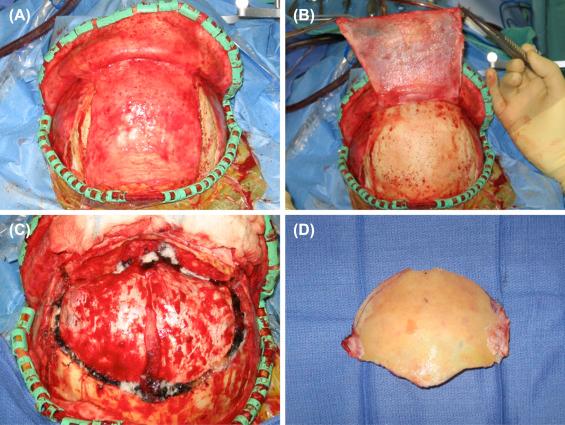
Subperiosteal elevation of the scalp and pericranial flap exposes the orbital rims anteriorly, with care taken to preserve the supraorbital nerve at the supraorbital notch. If the supraorbital notch is closed by a fibrous ring, the nerve should be displaced inferiorly away from the orbital roof subperiosteally. If the supraorbital ring is osseous, an osteotome may be needed to release the nerve from the orbital rim. The frontonasal suture is also exposed in the midline if a low-lying osteotomy at the nasion is desired. The lateral orbital rims can also be exposed subperiosteally down to the frontozygomatic suture after interfascial dissection of the temporalis fascia. The superior aspects of temporalis muscle and fascia are reflected inferiorly to expose the frontal keyhole just below the superior temporal line, behind the orbital rim.
Become a Clinical Tree membership for Full access and enjoy Unlimited articles
If you are a member. Log in here